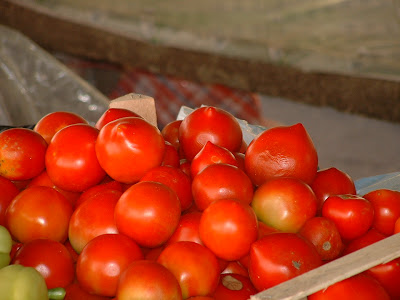Among the changes is the availability of certain food items. Now a mere three years ago, there were very few "fancy" goods on sale. You could easily get your locally grown vegetables in season, your various forms of salami, your polenta, and your coca cola. But there were a number of items that were less easy to find, or, to be completely honest, impossible outside maybe of a few specialist delicatessens in Bucharest (By the way, as a complete aside, is the plural of delicatessen delicatessens? It looks wrong.)
But slowly things started to show up. I first noticed this in the vinegar aisle, where the usual clear "white" vinegar ruled supreme, but gradually inroads were made by first apple/cider vinegar, then red wine vinegar, and now even balsamic. You still can't get malt vinegar for your chips, but then outside of the UK I've rarely seen that (you can get it in the US, where it is marketed as a "gourmet" product, because it's exotic and foreign).
Other things that have become available:
- Broccoli - I know to the outsider that will sound odd - after all broccoli is practically ubiquitous, no? Not here. It only existed in ice bound packets, untouched for decades down the bottom of freezers in the frozen section of some supermarkets. Now you can buy it fresh in the market. Occasionally.
- Capers - not fresh, obv., but in jars
- Foreign wines - you have to go to fancy places like Carrefour or Spar to get them but they exist. (Note: Hungarian wines were available previously, but people here would consider them only loosely foreign)
- Herbs. Fresh ones. Well, you could always get dill and parsley, and mint grows by the roadside, but things like basil and coriander were merely a kind of late night had-too-much-wine fantasy. Not anymore. You have to drive all the way to the Spar in Udvarhely to get them, but get them you can.
- Exotic crisps - with enticing names like "Hot Salsa" (about as hot as a November day in Csikszereda), and "Sour Cream and Onion".
- Courgettes. You could always get these kind of faux-courgettes, which were light green (as opposed to the more traditional dark), but now at the market you can buy real ones. Sadly the growing community have not quite sussed the vegetable properly yet, and tend to overgrow it and let it become too marrow-esque. By only buying the very small ones, I'm hoping to send a message. (Though that message is probably read as "Here comes that stupid English bloke again, he'll buy all these underdeveloped marrows")
- Soy sauce - Not sure who uses it and for what, since it doesn't seem to be a key ingredient in anything that anyone eats, but it has appeared on the shelves.
- Chick peas - Again not in any great abundance, but in more specialist shops you can find them. I remember when I arrived I asked about them but nobody was really sure what I was on about. This was even after I had taught myself the Hungarian word (csicseriborsó). Now I can even say the word, show people the peas themselves and they still have no idea what they are. You can also buy humous in certain places, on a lucky day.
- Fresh fish - the szekely tend to look upon fresh fish and other seafood as being the work of satan. Not so much trout which is fairly common, but anything else really, and until recently I knew of nowhere in town where you could buy fresh fish. Bizarre, huh? I suppose being so far from the sea, it's not terribly surprising, but in these days of foods having their very own carbon footprints, you'd think people would slowly get used to the idea. I even saw fresh octopus in the Spar in Udvarhely. I bet no-one bought it.
- Dijon mustard. Well, I think you can get it in Carrefour, but beyond that you have to be content with that much less flavourful vividly coloured Romanian Mici mustard
- Tortilla chips. You can actually get ones that are cheese-flavoured, but as "all cheese is sajt" as I like to say, oh-so-wittily, and as tortilla chips should be unflavoured anyway, this is of no value. Before the arrival of fresh coriander this lack was of no great consequence, since without salsa, who needs tortilla chips? But now I am able to make my own fresh and delicious salsa (particularly given the abundance of utterly fantastic locally grown tomatoes), the lack has grown into a desperate need. So desperate in fact that I considered making my own tortillas, just so that I could let them go stale and then fry them up. But then I found a recipe for making tortillas that said I needed something called "masa harina", and added that you couldn't really buy it in the shops, but if you lived near a tortillera (tortilla factory) they would sell you some. At which point I threw the book across the room screaming "If I lived near a tortillera I wouldn't be making tortillas, MORONS!", quite freaking out my family.
- Chutney - no surprise really as Indian food is hardly taking the country by storm, but occasionally I dream of a day when I can pop down the shop and buy a jar of mango chutney or lime pickle to go with my curry. I did actually bring some back from England once but in a moment of cross-cultural comedy my mother-in-law threw it away thinking it was jam that had gone bad.
















